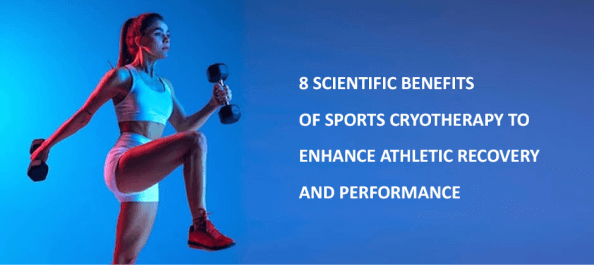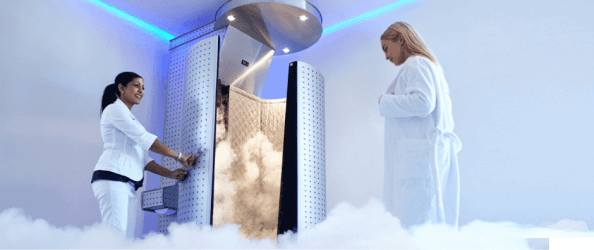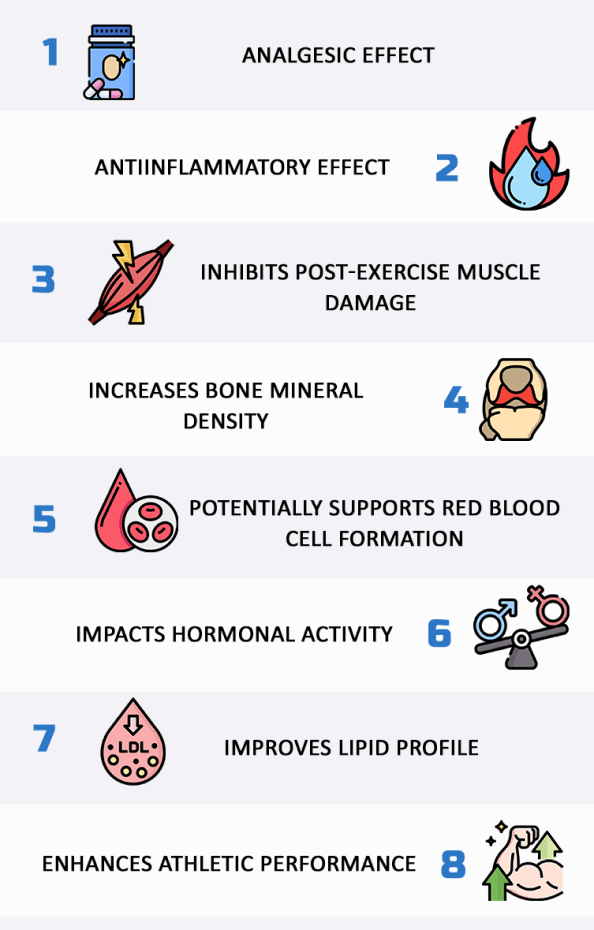
Whether you are a serious athlete with a grueling season ahead, or a weekend warrior with a guts-and-glory mindset, dealing with achy muscles, stiff joints and minor injuries is just part of the game. But having a solid recovery strategy is key to maintaining optimal performance and avoiding serious injury.
Athletes have relied on ice baths and cold packs for decades to soothe pain and reduce inflammation. But new technology has edged out ice in favor of cold nitrogen gas that achieves the same or better results in a fraction of the time.
Learn about the role of cryotherapy in sports, and the latest research on the many benefits of cryotherapy for athletes.
Whole Body Cryotherapy: What it is and How it Works
Whole body cryotherapy (WBC) exposes the entire body to icy-cold nitrogen gas in an enclosed chamber. During a cryotherapy session, temperatures inside the cryotherapy chamber plummet to sub-zero levels ranging from −166°F to -220°F (−110°C to −140°C). The user may opt to be completely in the buff, — with the exception of warm socks and mittens to prevent frostbite — or to wear just underwear or light clothing. Care should be taken to completely dry the skin of sweat and moisture prior to a cryotherapy session, to avoid frostbite.
A typical cryotherapy session lasts a short 2-3 minutes, compared to 30-45 minutes soaking in an ice bath. The brief exposure to extremely cold temperatures is enough to elicit the same therapeutic effects as a cold bath, while dramatically reducing discomfort.

Cryotherapy triggers a vasoconstriction response in superficial blood vessels that causes blood, fluids. lactic acid and toxins to be shunted away from soft tissues and into the visceral organs. Rapid removal of metabolic byproducts after athletic activity is thought to dramatically reduce post-exercise muscle soreness and accelerate tissue recovery.
8 Scientific Benefits of Sports Cryotherapy
The advent of cryo technology and its popularity among athletes has spurred widespread research on the mechanisms and benefits of sports cryotherapy. Here are eight major benefits of cryotherapy, uncovered by sports medicine researchers:
1. Analgesic effect
Cryotherapy has an immediate analgesic effect on soft tissues by numbing sensitized nerve endings, providing short-term pain relief. It has also been found to significantly reduce delayed onset muscle soreness (DOMS), commonly felt 1-2 days after intense training.
2. Antiinflammatory effect
Inflammation is a common response to intense exercise, thought to contribute to DOMS, and a natural immune response to tissue damage. Cryotherapy dramatically reduces inflammation in soft tissues as superficial blood vessels constrict, shunting fluids away from joints, muscles and connective tissues.
3. Inhibits post-exercise muscle damage
During and after exercise, oxidative agents are produced inside muscle cells that cause damage to the cells and cell membranes. If cell membranes break, which is common in intense sports, the agents are then released into the intercellular space, causing further damage. Whole body cryotherapy (WBC) disrupts post-exercise cellular activity, inhibiting and reducing muscle damage.
4. Increases bone mineral density
Root Causes of Skin Disorders and Premature Aging
Weight bearing exercise has been shown to increase bone mineral density, but WBC may have an even more profound osteogenic effect on bone formation. One study of rugby athletes found that WBC significantly increased levels of osteoprotegerin, a cytokine receptor that inhibits the production of osteoclasts, thereby decreasing bone catabolism and promoting bone formation.

5. Potentially supports red blood cell formation
While research has gotten mixed results, some studies have found that regular WBC sessions had a beneficial long-term effect on hemoglobin levels and red blood cell formation in athletic populations. This is important, since red blood cells transport oxygen to muscle cells during physical activity, enhancing ATP production.
6. Impacts hormonal activity
WBC has been shown to trigger the release of endorphins, the feel-good hormones that give you a general sense of wellbeing. WBC also promotes the release of norepinephrine, a neurotransmitter that increases alertness and enhances reaction time. Norepinephrine is also a mood-enhancing hormone.
7. Improves lipid profile
Regular WBC sessions are found to enhance lipid metabolism and improve the overall lipid profile of athletes by increasing HDL cholesterol levels and decreasing LDL levels.
8. Enhances athletic performance
Elite athletes do everything they can to gain a competitive edge over their rivals. But you don’t have to go pro to enjoy the benefits of sports cryotherapy for faster recovery and enhanced performance. Contact InVita Wellness today to schedule your whole body cryotherapy session. And be sure to ask about localized cryotherapy to reduce pain and inflammation, and accelerate the healing of sports injuries.
Cryotherapy for Athletes in NYC
Elite athletes do everything they can to gain a competitive edge over their rivals. But you don’t have to go pro to enjoy the benefits of sports cryotherapy for faster recovery and enhanced performance. Contact InVita Wellness today to schedule your whole body cryotherapy session. And be sure to ask about localized cryotherapy to reduce pain and inflammation, and accelerate the healing of sports injuries.
Resources
Galliera, Emanuela, et al. “Bone remodeling biomarkers after whole body cryotherapy (WBC) in elite rugby players.” Injury 44.8 (2013): 1117-1121.
Patel, Karan, et al. “Whole-body cryotherapy in sports medicine.” Current sports medicine reports 18.4 (2019): 136-140.